In Australia, most discourse around disability inclusion has centred around accessibility and infrastructure. More specifically, around removing stairs and putting in ramps, providing support to students with a disability, making doors wider and ensuring that all social venues, workplaces and community facilities can be accessed by people with a disability. But have we ever stopped to consider that the real issues around exclusion move far beyond matters of physical access and instead involve promoting attitudes of inclusion, nourishment and acceptance for people with disabilities?
As an aspiring university academic with cerebral palsy, attitudes towards disability and all the issues this very concept entails have been at the forefront of my experiences in daily life. Whether it’s trying to meet people or trying to convince an employer to give me that coveted job, it seems most people’s perception of disability inclusion is to remove a couple of stairs from a building or facility… problem solved.
From my experience, any attempt to achieve disability inclusion requires far more effort than that. Let me give you an example: Suppose an 18-year-old wheelchair user fresh out of school wants to attend a party. Accessing the venue may not be the primary issue. A ramp is already there, there’s an accessible toilet which is easy to use and the dance floor is big enough to bust out some moves and a few burnouts. Something else or rather some others at the event are amiss. A group of people this person knows choose to simply ignore them, smirking and rolling their eyes at them. Their attempts to mingle with these people at the party are suddenly quashed. But why? Is it the shirt or the choice of drink? Or is it because of the sight of that wheelchair?
These questions often permeated my mind as I transitioned from a shy schoolkid into the life of an adult with cerebral palsy. To most observers it’s the elephant in the room, the thing nobody dares ask or talk about, possibly out of fear of offending the person with the disability or sounding naive, but for me open and honest dialogue about disability is the best way to achieve a truly inclusive society.
Let me give another example: That same individual is now 21 and a skilled researcher. They apply for a job but as soon as they ask if the venue for the interview is wheelchair accessible, they get cut off. Again it begs the question, is disability inclusion simply about changing infrastructure? Or is it more to do with people making an effort to get to know the person with the disability for who they are and what they want to achieve, and then making that happen by accommodating their needs?
I’ve always subscribed to the Australian spirit and mentality of never giving up, being the underdog and fighting my way through adversity or difficulty. It has served me well and continues to serve me well. How did I overcome these obstacles then? Through sheer persistence, stubbornness and a refusal to give up or walk away from a challenge. I applied for several jobs and have found a research role now. I’m also on the way to beginning my Ph.D. in social work next year. I also hope that through my writing I get to connect and network with others, because writing and storytelling is a powerful tool that brings people together and has no physical limitations or boundaries.
Through my experiences with cerebral palsy I have realized the importance of learning from the mistakes and shortfalls of others. But most significantly I’ve realized that true disability inclusion is about how we accept ourselves for who we are, and accept others no matter what their or our disability is.
Getty photo by Tifon Images.

